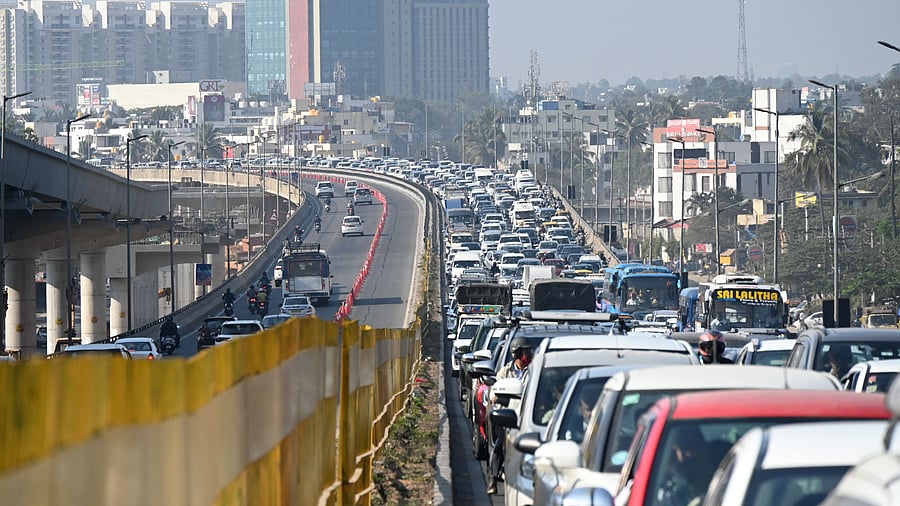
Image showing heavy traffic on Bengaluru streets. For representational purposes.
Credit: DH File Photo
Bengaluru: Pollution levels in Bengaluru have increased after the hike in Namma Metro fares on February 9, a look at the data from the National Air Quality Monitoring Centre shows while an ongoing research at the Indian Institute of Science shows that those who dropped out of the metro were shifting to road transport.
The Bangalore Metro Rail Corporation Ltd (BMRCL) has acknowledged the drop in the ridership. “We can say that there is a drop of about 10.5 per cent in our average daily ridership. We are still assessing the numbers,” Yashvanth Chavan, the official spokesperson said.
The percentage works out to about 80,000 to 90,000 rides which shifted to cheaper modes.
“The cost of my ride from Yelachenahalli to MG Road has doubled to Rs 66. Paying another Rs 66 for the return journey and a parking fee of Rs 30 is very costly. Instead, I choose to ride my Bullet mobike which requires 1 litre of petrol but is still cheaper and convenient,” said Sathyanarayan M, a content developer.
According to the source apportionment study notified by the Karnataka State Pollution Control Board (KSPCB), the transport sector accounts for 40-51 per cent of air pollution followed by resuspension of dust (17 per cent to 51 per cent). The pollutants include the dangerous PM 2.5, along with PM 10 and toxic gases emitted by vehicles.
Data recorded at the peak hours (10 am and 6 pm) on five Mondays -- two preceding the fare hike on February 9 and three after -- showed an increase in pollutants on February 10, the first Monday after the fare hike.
While the average air quality index (AQI) numbers showed a spike, drilling down the data to understand the changes in the levels of different pollutants showed the shifts in major pollutants.
For instance, the monitoring centre at Jayanagar 5th Block showed that before the fare hike, the average PM 2.5 in the morning and evening peak hours was between 43 and 54 microgram per cubic metre. The range hit 112-114 microgram/cubic metre on February 10.
On February 17 and 24, the average remained at 68 to 105 microgram. PM 2.5 are small particles that are associated with chronic lung disease from asthma to cancer. The bigger PM10 also saw an increase from an average of 71-77 to 112-117 microgram/cubic metre.
At the Sustainable Transportation Lab of IISc, a team led by Professor Ashish Verma has been tracking what happened to the riders who dropped out of Namma Metro.
“Our study shows that those who dropped out of the metro are opting for affordable modes of transport, starting from the city buses and two wheelers and, to an extent, cars. We will be able to put a number on these changes within the next two days. Empirically, the AQI data suggests the hypothesis that it is correlated to people moving away from Namma Metro to road transport. While there could be some effect of changing weather,” he said but noted that it was safe to say that road trips cause more pollution than Namma Metro.
KSPCB Member Secretary S S Lingaraja refused to speak. A senior official, however, said apart from the traffic, construction dust was a major source of pollution. “Vehicle movement is a major cause for the resuspension of dust in the air. So, we can safely say that there is a need to reduce vehicles and shift to public transport,” the officer said.